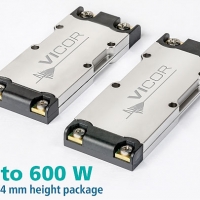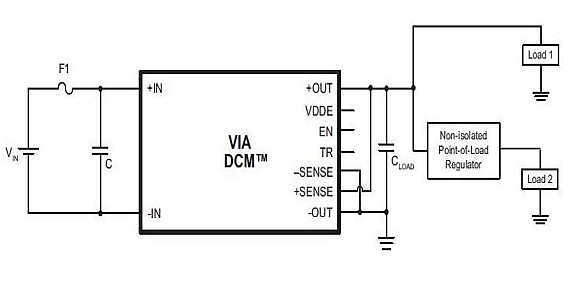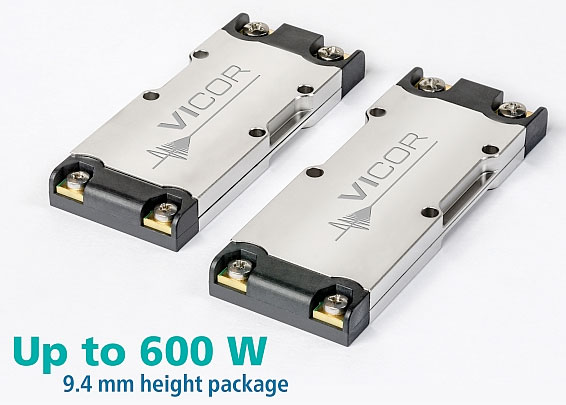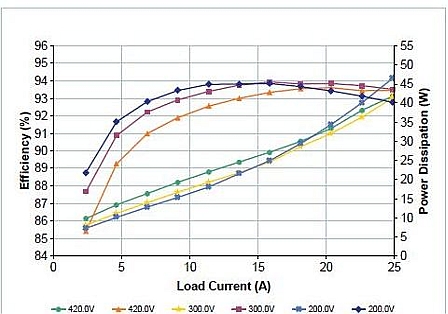Vicor’s innovative packaging for next-generation DC-DC brick power modules

I have always been highly impressed with Vicor’s unique initiative in packaging that pushes the envelope of thermal and size in a system since my circuit design days, to my applications work with a Vicor competitor and even today as an editor and tech writer. At the end of this article, you can read a few more fairly recent examples of Vicor packaging initiatives covered on EDN.
Well, they have done it again and designers who need high voltage DC-DC bricks with some “must have” features, please read on.
Higher efficiency in DC-DC power modules is constantly being pushed to the limit---just when we think we have reached that limit---another clever design breakthrough is made; good designers always find a way. Efficiencies in the 60% to 70% range used to be the standard, now designers expect it to be in the range of 85% to 90% and even higher. This dramatic improvement has been achieved largely through the development of well-designed board-mounted "bricks" with industry-standard form factors, which leveraged the availability of the best small, efficient power-management ICs. The popularity of these bricks then spurred development of even-smaller, more-efficient ICs – all of which led to still-smaller bricks, in an ongoing back-and-forth improvement cycle in which Vicor excels.
This trend hasn't stopped, while new demands have been added. More than just increased efficiency, designers want and need an overall form factor which meets the mandates of their applications. They want ease of use with minimal headaches or risk, with no need to be concerned about having to add an array of external components for input or output filtering, or for protection against system electrical or thermal excesses. And the solution had better be cost competitive.
An old problem with new innovative answers
The next step in packaging by Vicor is an advanced design which provides small, easy-to-use, totally enclosed modules based on high-power ICs. This design combines the size and power-density advantages of the latest ICs with the ease of use and convenience of dropping in a brick with the assurance of being able to rely upon its performance and reliability and then more quickly move on to the next challenge in their power architecture design.
Their latest family of DCM DC-DC converters in Vicor Integrated Adapter (VIA) packages meets these designer needs for a robust design and achieving, the usually elusive, targeted-time-to-market. Housed in small-footprint, low-profile chassis-mount packages, these converters offer peak efficiency up to 94% across a wide range of supply loads, and also integrated EMI and transient filtering which greatly reduces the need to add EMI/RFI and surge-protection to the supply subsystem design. Soft-start ramp-up is also built-in and requires no additional external components, thus minimizing the risk of turn-on transients which might stress the load circuitry (Figure 1).

Figure 1 A representative configuration with a single DCM3714 module configured for local-sense operation to a non-isolated point-of-load (POL) regulator, as well as connected directly to another load; note the simplicity of the design and minimum additional components. [From data sheet, page 2]
It's not only efficiency which distinguishes these modules, it's their size as well. With a width of just 36 mm and length of 86 or 95 mm, and at only 9 mm thin, they have an incredibly small and slim overall form factor, Figure 2. Yet this small size doesn’t compromise basic DC-DC performance, efficiency, thermal impedance or ease of use in a design.

Figure 2 The high-performance, highly integrated DCMs in VIA packages measure just 36 mm wide × 86 (or 95) mm long, and only 9 mm in height, yet offer features and ease of use which is better than larger modules. [From data sheet, page 1]
Every DCM in a VIA package has just four basic connections – two for the unregulated input source and two for regulated output – plus a five-pin control-signal connector, and requires a minimum of external components. This extra connector can be left disconnected, in which case the DCM provides nominal output trim voltage with local sense only, or it can be used for remote sensing to compensate for IR drop in supply rails. Other critical features which users often have to add, such as protection against input undervoltage, output overvoltage, or over-temperature, are built into these compact modules.
The five initial DCMs in VIA packages highlight the performance characteristics of the family. The DCM3714 family of isolated DC-DC converters accepts a wide input range of 200 to 420 Vdc (300 Vdc nominal) and provides a variety of regulated, trimmable output voltages (12V, 24V, 48V nominal at the moment, with more models to come), with up to 600 W capacity. These converters feature up to 94% peak efficiency and achieve this over a wide range of loading from about 20% of capacity to maximum rating, Figure 3. There's also a lower-voltage family, the DCM3414, which is designed for 28 Vdc nominal input (16 to 50 V range) and an assortment of outputs (12V, 24V, 28V out at the moment, with more to be released soon), and delivers up to 320 W.

Figure 3 Efficiency and power dissipation for the DCM3714 converter versus load at three input voltages (200, 300, and 420 Vdc), with case temperature of 25ºC and output at nominal trim; note that efficiency is above 90% with outputs over the wide range from 3 A to 25 A. [From data sheet, Figure 11]
These DCMs in VIA packages focus upon density, thermal performance, and isolation. I like the low profile design because it opens up new opportunities for designers to mount on a chassis or PCB, especially in tight board spacing in a card chassis. The thermal performance of this type of package is very important to ease cooling requirements. For chassis mount versions, in most cases the chassis alone is usually a sufficient sink without need for additional heat sink or fan. Another important feature is the light weight (116.0 grams/4.10 oz) which opens up opportunities for use in systems that have maximum total weight requirements.
There are no reference pins on the primary side in this high voltage architecture, DCM3714 modules are designed with reference pins on the secondary side where the output voltage is below 60V and therefore SELV compliant. This frees the designer of any risk of these control pins (and lines connected to it) being pulled to a high primary voltage in case of cabling failure, thus reducing the risk of damage to downstream systems and assuring user safety. This feature also allows for the addition of user-provided feedback loops (if desired) without crossing the isolation boundary, thus further assuring safety.
Environmental
This package's environmental robustness is confirmed by the MIL-STD-810 rating, with three temperature grades: C (-20ºC operation) and T (-40ºC operation), both available now, and M (-55ºC operation) coming soon.
